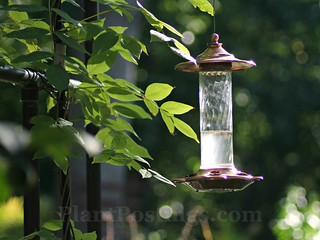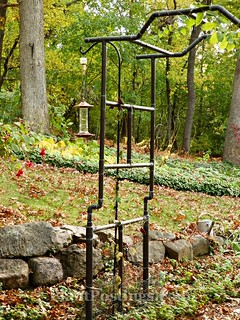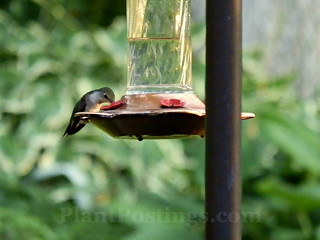Two Book Recommendations for the New Growing Season
I've recently had a chance to review a couple of excellent garden books. The topics are very different, but they're both full of great information and beautiful photos.
The first is "Vegetables Love Flowers," by Lisa Mason Ziegler, with photography by Bob Schamerhorn. This book covers a topic close to my heart: companion planting. I've been practicing it for years, and it allows the gardener to grow plants organically--no need for pesticides, insecticides, or other chemicals. Plus, the plants are healthier, yields are greater, and you get beautiful flowers and veggies!
As Ziegler, the author, describes, "It's simple really: Flowers attract pollinators, beneficial insects, and other good creatures to the garden that provide nature’s most powerful pest control, pollination, and more!
"There's no better way to bring flowers into the vegetable patch than with a cutting garden. A perfect match--harvesting fresh cut flowers each week alongside the vegetables keeps fresh blooms coming all season long. This constant presence of flowers in the garden keeps all these good guys right where we need them--in the garden."
"Vegetables Love Flowers" explains why to grow flowers, how to grow and keep a cutting garden, and how to do it all pesticide-free. It also recommends flowers to grow in your vegetable garden and offers plant combinations that work well together.
The second book I'm recommending is "Shakespeare's Garden," by Jackie Bennett; including photography by Andrew Lawson.
The thing that's really nifty about this book is the history contained in its pages. It describes, in detail, the several gardens that provided inspiration for Shakespeare's writing and life.
More than four centuries after he lived, notes the publisher, "When we think of rosemary, violets, or daffodils, we're likely to remember a quote from one of Shakespeare's 39 plays and 154 sonnets. Here, we find the roots of those timeless inspirations."
The book offers great information on the specific 17th Century plants that Shakespeare referenced in his work--how they were used and the various meanings (symbolic and practical) that his audiences would have understood. The text is as interesting as the photos and illustrations.
These are two uniquely informational and stunningly beautiful books--one is a great practical guide to growing flowers and vegetables; the other is a historical treasure for gardeners and literary fans.
~ ~ ~ ~ ~ ~ ~ ~ ~ ~ ~ ~ ~ ~ ~ ~
Hummingbird Feeders In Action
 Those of us in the Americas are so fortunate to have hummingbirds visit our gardens! Here in the Midwest--during the spring, summer, and fall--Ruby-Throated Hummingbirds are plentiful. It's entertaining to watch them come and go--visiting flowers and feeders, and perching here and there in the garden.
Those of us in the Americas are so fortunate to have hummingbirds visit our gardens! Here in the Midwest--during the spring, summer, and fall--Ruby-Throated Hummingbirds are plentiful. It's entertaining to watch them come and go--visiting flowers and feeders, and perching here and there in the garden.This product review takes a look at two specific hummingbird feeders that might help you attract more hummingbirds: The More Birds Glory model and the Perky-Pet Hummerbar. I can recommend both of these feeders for different purposes and reasons.
 First, the More Birds feeder: I did not receive any compensation for my review of this feeder. During the past several years, however, it has become my go-to feeder. I like it because it's easy to clean, it's attractive on my arbor and in other locations around the house, it doesn't leak, and the yellow jackets and other bees don't seem to swarm it. I do use homemade ant traps with all my feeders to keep the ants out of the nectar.
First, the More Birds feeder: I did not receive any compensation for my review of this feeder. During the past several years, however, it has become my go-to feeder. I like it because it's easy to clean, it's attractive on my arbor and in other locations around the house, it doesn't leak, and the yellow jackets and other bees don't seem to swarm it. I do use homemade ant traps with all my feeders to keep the ants out of the nectar.I've seen some reviews that mention this feeder tarnishes, but to me that simply adds more character.

Most of all, however, the hummingbirds love it!
The other feeder I'm recommending is the Perky-Pet Hummerbar. (Disclaimer: I did receive a sample for trialing this one.)
The Perky-Pet Hummerbar would be perfect in an open area where many hummingbirds come together. I'll probably change the location of mine next year, and I might wait to hang it until the fall migration when the hummingbirds tend to fight over all the flowers and feeders.
The Hummerbar has 22 feeding stations and plenty of room for multiple birds to visit. You can see it in action at this link: Perky-Pet Hummerbar. The things I like about this feeder are the multiple, horizontal ports that discourage fighting; the pleasant design; and the fact that (in theory) it allows you to see many birds in action. Since I didn't install mine until summertime and it wasn't out in an open area, I only saw single birds at a time visiting it.
Note: This feeder must be completely level to prevent leaking. Also, you must hang it before you fill it or you'll probably have nectar running down your arms and legs because it tips easily until it's hung perfectly straight. I also found it a little challenging to take down and clean until I worked out a system, and then it was easier.
I look forward to using this feeder again next season, too!
Here are two videos showing these feeders in action in my garden. Enjoy!
~ ~ ~ ~ ~ ~ ~ ~ ~ ~ ~ ~ ~ ~ ~ ~
Another DEET-Free Solution
Here I am again reviewing another mosquito-repelling product. I'm happy to report that this one works well. It's the Thermacell Mosquito Repellent Appliance, and it's available in a few forms, including a patio lantern, a camp lantern, and a handheld device.
I tested the handheld device in several settings:
• Watching fireworks at dusk;
• Sitting on the front porch in the shade;
• Gardening in various locations around my garden.
I even took it into the deepest woods at the back of my garden and I didn't have to swat a single mosquito. I know it worked, because when I turned it off, the bugs started swarming and biting me again. My sister-in-law, also an avid gardener, said it worked for her, too.
The product I tested comes with a butane canister and three repellent mats, saturated with a compound similar to the one in Chrysanthemum flowers. The company says it creates a 15-by-15-foot area free of mosquitoes, black flies, and no-see-ums. It did protect the area around me and my family, from head to toe.
Each mat lasts for about four hours, and each cartridge for about 12 hours. You can tell when it's time to replace a mat because it changes from blue to white.

It's pretty easy to remove and insert new mats and cartridges.
The only inconvenient thing is that I had to set it down in a new place every time I moved around in the garden, but I found out they do sell a holster that can be used with the device. Or, you could probably figure out a way to strap it to your waste, making sure to keep the hot parts and the emission away from your body.
The scent is not strong, but you can tell when it's on.
One thing to keep in mind, and they strongly warn about this in the instructions, is that the repellents are toxic to aquatic life, including fish. They recommend recycling the used mats and cartridges if you can, or disposing of them in the trash, and never in a stream, river, lake, or ocean.
It's a trade-off, but it's a good option for certain situations, and it does repel mosquitoes without having to use DEET.
~ ~ ~ ~ ~ ~ ~ ~ ~ ~ ~ ~ ~ ~ ~ ~
Hey, Don’t Bite Me
I’m a mosquito magnet. When it’s hot and humid and the wind
is calm, all I have to do is walk outside and the little creatures attack my
ankles, arms, neck, and all around my face. Not fun!
I don’t like the idea of slathering on DEET,
but I definitely don’t want to get Lyme
Disease or West Nile Virus.
So, I’m always looking for an effective, natural, healthy alternative to DEET
products.
Recently, I tested the effectiveness of Mosquitno wrist
bands. The citronella-infused bands come in two sizes—for adults and children.
The child size actually fits comfortably on a small adult wrist, like mine, and
the adult size is about right for around my ankles.
The company website says the bands are available in nearly a dozen colors, they’re waterproof, and they last for up to six days
or 150 hours of exposure.
Another nice feature is that each band comes in a
resealable zip-top bag, so you can reuse them several times before they become
ineffective.
But do they work? To be honest, I had mixed results. I experimented
with several conditions:
- Out in my wooded garden—summer clothing, and wearing one wrist band in tandem with a spray-on, light, 5% DEET product (which I usually use);
- Again in the garden—summer clothing and wristband, with no other repellent products;
- Hiking through tall grass—again with a combination of the 5% DEET product, but one band on my wrist and one on my ankle, (and long pants);
- During a suburban walk—summer clothing and light DEET product alone, no wristbands; and
- At a family picnic, sitting in light shade on a patio—summer clothing and wristband only.
The most effective deterrent combination was long pants,
hiking boots, a wrist and ankle band, and the spray-on light DEET product. The
least effective situation was out in my garden with the wristband, regular
summer clothes (exposed arms and legs), and no other repellent. The mosquitoes
still swarmed me, so the wristband without spray-on repellent wasn't very effective (but, like I said, I’m a mosquito magnet).
The other experiences fell somewhere in between. For
example, at the family picnic, wearing summer clothing, I wasn’t bothered much
when using the wristband without the DEET spray. And my young niece used one
and said it worked for her, too.
My recommendation: Use Mosquitno wrist bands in combination with a light DEET spray, or some other effective mosquito repellent. The bands
have a strong citronella scent—especially right out of the bag. It doesn’t
bother me—in fact I find it rather pleasant. But other people might find it too
strong.
One nice thing is that the company recycles the silicone.
For every 10 bands you return, they send you two new bands for free.
The company also offers SpotZ—heavy-duty, round citronella stickers
that you can place on clothing, hats, strollers, shoes, or anywhere.
(They fit
perfectly on the backs of my hiking boots).
You can order direct from the company’s website, mosquitnoband.com, on Amazon.com, and at various retailers.
~ ~ ~ ~ ~ ~ ~ ~ ~ ~ ~ ~ ~ ~ ~ ~
A Favorite 'Place' to Shop
Years ago, I discovered an organic products company, Gardens Alive!, whose offerings run the gamut from iron phosphate to prevent slug damage, to Kelp meal to improve soil texture and fertility.
I've personally used the latter, along with the company's insecticidal soap, and maggot fly traps when we had Apple trees in our previous garden.
It's fun to glance through the company's print catalog or visit its website at gardensalive.com to see the unique "green" products it provides. Gardens Alive! also offers a free newsletter, and links to useful organic gardening information.
I think it's time for some "Christmas in July" garden shopping...
~ ~ ~ ~ ~ ~ ~ ~ ~ ~ ~ ~ ~ ~ ~ ~
Excellent, eco-friendly towels
I’m not kidding. These really are fantastic towels. I received no payment for my first review on this product page. I simply want to share information about some nifty towels.
They’re manufactured with 30% Bamboo fibers. I like the idea of purchasing products made from Bamboo for many reasons, including the fact that Bamboo grows very fast, so it’s renewable and sustainable. Supporting Bamboo agriculture supports maintenance of established rainforests. And Bamboo fiber is strong, very soft, and a wonderful blend with Cotton.
Read more about the benefits of Bamboo in this excellent post from a blogger with The New York Times.
In addition to these eco-benefits, I simply like these towels because:
• They’re very soft, substantial, and warm. When I picked them up in the store, they seemed like the perfect weight, size, and tactile experience. Just right for my guest bathroom.
• Vera Wang designed them. OK, here it comes. I apologize for gushing, but I like just about everything Vera Wang—clothing, household items, whatever. She has a practical, no-nonsense, friendly style that I can’t resist.
• They are white. I almost always buy big, white towels because they can be easily cleaned and sterilized with bleach. Well, of course I had to buy some blue smaller towels for trim.
• The price was reasonable. I honestly can’t remember what I paid, but I remember it was a good sale price. I rarely buy products full price, and if I remember correctly even the regular price was good, considering the quality.
If you’d like to know where I found these towels, send me an email (plantpostings@gmail.com) or leave me a note and I’ll send you a private message, because this is not an ad for that particular retailer. I simply love these towels!


















